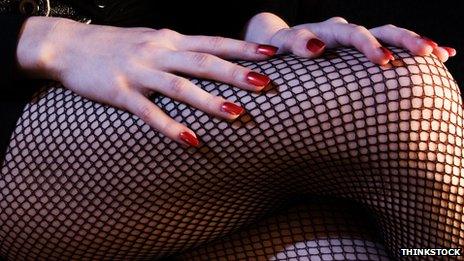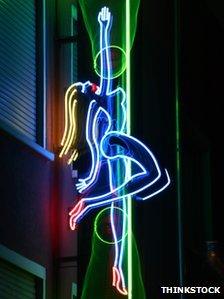The rise and fall of lap dancing
- Published
- comments

Strip clubs across England and Wales face closure thanks to changes in licensing rules, reversing a previous boom. How did the explosion in lap dancing change the country?
You recognise them by their names - broad, unsubtle allusions to sex and glamour like Secrets or Medusa or Platinum Lace.
At one time, the entertainment they offer would have been confined to back alleys.
Yet at present, for good or ill, lap dancing has colonised the British High Street.
Within recent memory, British venues offering the spectacle of women publicly undressing for male edification typically were either less-than-salubrious pubs or working men's clubs or found amid the red lights of London's Soho.
But the past decade has witnessed the rise of the "gentleman's club", frequented by City bankers and Premiership footballers, their "VIP rooms" replete with expensive champagne.
New planning rules mean their rise could be curtailed, however. To critics, they are, beneath the respectable veneer, no more than seedy outposts of the sex industry which make communities feel unsafe and commercialise the exploitation of women.
Their advocates insist they are safe, clean, professionally run businesses which answer a market demand and offer performers the opportunity to earn big money.
Few would dispute, though, the impression they have left on British society. Between 2004 and 2008 their number doubled to 300.
It was a period that coincided with the popularisation of certain aspects of the aesthetic of stripping. Pole dancing became a common activity at exercise classes and hen parties, while burlesque nights featuring striptease grew as a socially-acceptable form of entertainment.
Perhaps as a consequence, lap dancing clubs began to claim to be attracting a female clientele. One chain, Platinum Lace in London, insisted women made up 25% of its membership.
The profile of dancers changed too. A 2010 University of Leeds study, external found that a quarter of lap dancers were graduates.
"There was a complete normalisation of part of the sex industry," says Jennifer Hayashi Danns, co-author of Stripped: The Bare Reality of Lap Dancing. Danns herself performed for two years in such clubs to pay her way through university.
"We believed it was different from what had existed before - that it was an aspirational career choice. The seedy, sleazy side of it was sanitised. It's extraordinary how acceptable it became."
Of course, the growth of lap dancing took place in the context of a long-term trend of increasingly liberal attitudes about sex and a dramatic rise in the availability of pornography.
But legislation played a crucial role. From 2003, licensing laws put the clubs in England and Wales in the same category as cafes and bars, meaning they could only be stopped from opening if they attracted crime, were a nuisance or endangered the public.
With council licensing committees often powerless to reject applications, the number of clubs surged.
But this trend was arrested in 2009 when the law changed and any venue offering lap dancing, pole dancing or striptease was reclassified as a "sex encounter venue". Additionally, all lap dancing clubs were obliged to apply for permission to continue trading after April 2012.
And now, just as the operators of chains like Spearmint Rhino discovered there were profits to be made promoting lap dancing, local politicians are concluding there are votes to be won by curbing it.
Already, 10 local authorities have voted to adopt "nil" policies, refusing permission for any new venues. Tower Hamlets, which currently has 11, wants to be the first council in London to ban the practice altogether.
Recent months have seen three existing clubs in Leicester having their licences refused, while Oxford's only lap dancing club has had its application turned down by the council.
Leaders in these areas say they are reflecting the wishes of the communities which elected them. The industry, however, views the matter quite differently.
Peter Stringfellow, who owns two "gentleman's clubs" in London, says a handful of "moralists" and "extreme feminists" were responsible for driving the agenda.
"My experience of provincial councillors is that they are closed-minded with regards to anything to do with sex."
Stringfellow expects that most non-metropolitan parts of the country will revert to being largely free of lap dancing, with the capital's status as the focal point for adult entertainment remaining unchanged. However, he believes that the legacy of the brief lap dancing fad will be a favourable one.
"It's been a positive force in terms of our sexual attitudes," he says. "These clubs broke down the fear a lot of people have about sex."
For those who fought for the law to be tightened, of course, lap dancing created rather than ameliorated fears. The group Object, which lobbies against the sexual objectification of women, argues that these venues make women feel unsafe and create "no go" areas.
Kat Banyard, who led the women's rights group Fawcett's campaign for reform of the way lap dancing was licensed, says the lap dancing boom would never have happened if local people had had the power to prevent it.
"What had been seen as these fringe, sleazy outfits became part of the average High Street, and people were unable to do anything about it.
"They normalised this idea that it's acceptable to treat women as sexual objects and to buy sexual services. But what our campaign proved was that people have the power to fight back."
In late 2011, academics at the University of Kent began carrying out a 12-month study into the effects of lap dancing clubs on communities.

But until this research is complete, hard data surrounding the impact of lap dancing clubs remains fairly limited, according to Birkbeck University's Dr Belinda Brooks-Gordon, author of The Price of Sex: Prostitution, Policy and Society.
As such, she argues, local authorities are making decisions about whether to grant licences without full access to the facts.
"You can argue that it's a better thing for the men who visit them to be interacting with other people than to be viewing pornography at home, alone," she says.
"Stripping always existed - it just used to exist in working men's clubs. I don't think lap dancing has so much normalised it as professionalised it. Women do it for a few years in order to earn substantial sums of money."
But for some women who took up this opportunity, the cash did not compensate for the realities of the job.
Danns, 28, regrets that her time as a lap dancer made her a harder, more cynical person.
She admits she was initially seduced by the notion that modern lap dancing was a safe, secure expression of female empowerment. In fact, she says, her experience was defined by the damage it gradually inflicted to her self-esteem and the regular verbal, and sometimes physical abuse she received from customers.
"There's a generation which is used to a culture in which it's normal that everything has become a commodity," she says.
"Some men come in and they love women. But others use it to vent the bitterness and frustration that they have against women. They aren't being challenged about it and that's damaging for everyone."
Whichever side of the debate is correct, the era of expansion for British lap dancing appears to be over. Its impact on British culture and sexual attitudes may prove to be longer lasting, however.